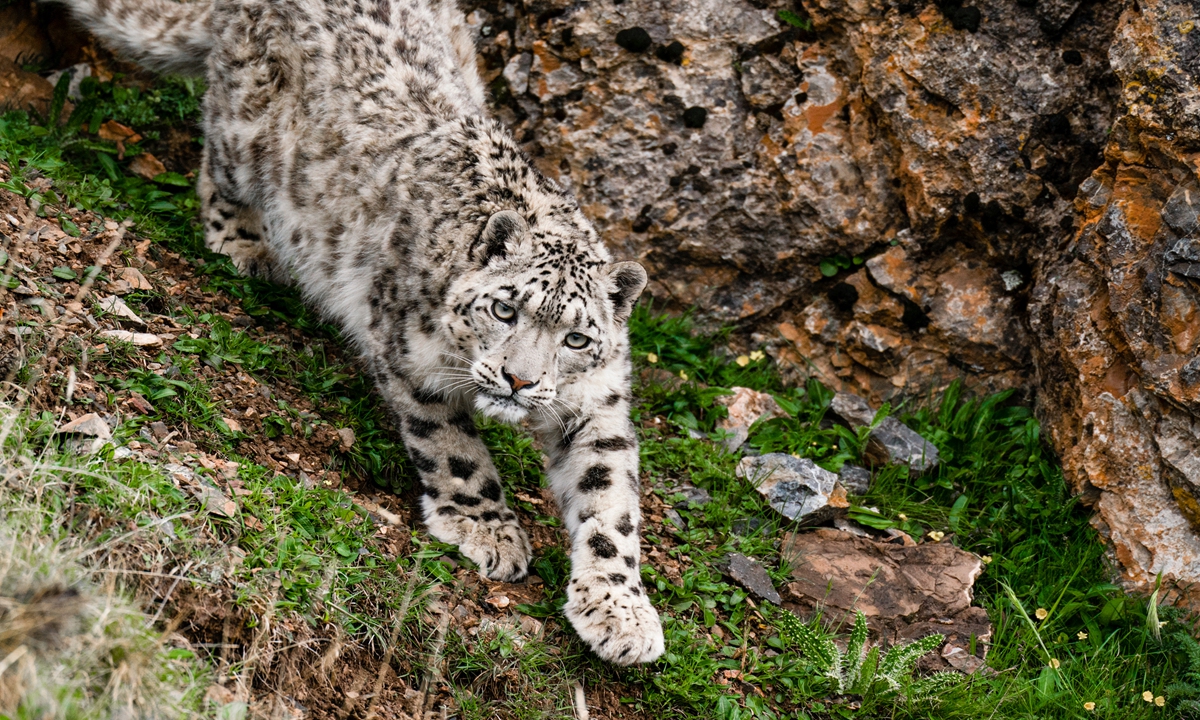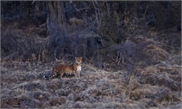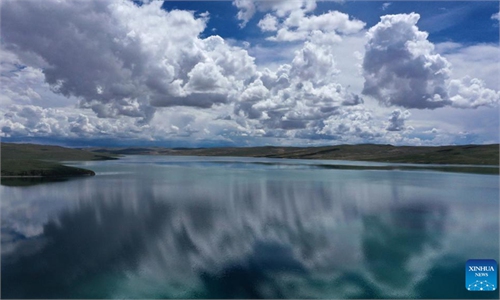Photography meets conservation: Tibetan herdsmen ‘capture’ snow leopards through lens, guard ecological sanctuary in Sanjiangyuan region

Three Tibetan herders take photos of wildlife in Zadoi county, Qinghai Province, on December 12, 2020. Photo: Courtesy of Wild China
Located in the heart of Sanjiangyuan National Park in Angsai township, Yushu Tibetan Autonomous Prefecture, Northwest China's Qinghai Province, 31-year-old Tibetan herders Ciding and Dajie, along with 34-year-old Kunchochopeng, have recently been in high spirits. Not only did they successfully dig up a large quantity of cordyceps, but they also had the opportunity to participate in a film that captivated audiences both domestically and internationally, a film featuring no movie stars.
The documentary Snow Leopards and Friends recently premiered at the Shanghai International Film Festival, with premiere movie tickets selling out within just 50 seconds. Interestingly, more than 70 percent of the footage in the film was captured by these three Tibetan herders-turned-photographers.
They may be the people closest to snow leopards in the world. As residents of the same area as the elusive snow leopard, herdsmen photographers enjoy a unique perspective that professional photographers may struggle to replicate. Bonding over their shared experiences of photographing these magnificent creatures, these herders have assumed a dual identity - that of both herders and photographers.
Their experiences reflect a shift in local perceptions of snow leopards, from antagonism to conservation. Through their films, they capture the intricate and symbiotic relationship between humans and nature, showcasing moments of interaction and harmony with the environment.
Tracking king of snowy mountains
The snow leopard is known as the "king of the snowy mountains." During the dusk or dawn after rain, it likes to stand alone on the snowy mountaintop, overlooking the canyons along the Lancang River, inspecting its territory and appraising its prey. The leopard species live on the ridge near the snow line, and the color of its fur blends in almost entirely with the snow, making it an almost impossible subject to capture for many wildlife photographers. However, the species share the land with people in the Angsai Grand Canyon.
Local residents and their domestic animals live alongside the predators. When a snow leopard is hungry, under cover of darkness, the "shadow among the rocks" becomes a silent assassin.
In the past few decades, local people have used Tibetan mastiffs and hunting guns to defend themselves against snow leopard attacks. This has resulted in only a small number of surviving snow leopards. Since the year 2000, when the entire region became part of the Sanjiangyuan National Nature Reserve, and the herdsmen's firearms were confiscated, the number of snow leopards, bears, and wolves has slowly increased.
Growing up in this transition, Ciding always hoped to become a friend of the local people's former natural enemies.
The young herder is the father of two children, and in order for his family to live a good life, in addition to herding and digging for caterpillar fungus, he was recruited to become an ecological patroller in 2016, mainly responsible for cleaning up the mountains and installing infrared cameras to detect wildlife. At that time, he didn't realize what a unique world he had entered.
In January 2016, Ciding rescued an injured snow leopard. When the wounded animal recovered and was ready to be released back into the wild, the Angsai village secretary invited Xi Zhinong, China's top wildlife photographer to capture images of the precious moment.
Xi found that locals like Ciding were familiar with their surroundings, and were able to move freely in high-altitude areas. They also possess eagle-like visual acuity, making it easier for them to spot rare wildlife species that are difficult for ordinary people to see and capture on camera.
The shared concern for snow leopards has brought local Tibetans like Ciding and Xi together as friends, and such relationships help in mentorships and apprenticeships. Ciding, Dajie, and Kunchochopeng are the first group of members in Xi's "Nomad Photographer Growth Plan."
"Whoever can capture a photo of a snow leopard is the most capable person," Kunchochopeng told the Global Times.
Dajie and Kunchochopeng used the money they saved from harvesting caterpillar fungus to buy their first cameras. Without any training, they relied on their instincts to blindly press the shutter button. However, Xi always encouraged them to continue photographing wildlife and provided them with more professional cameras.
From 2016 to 2022, Xi and three nomad photographers spent six years filming the documentary Snow Leopards and Friends. This was a test of patience. During the longest stakeout, they took turns guarding the cave for 35 days just to capture the scene of a snow leopard mother nursing her cubs.
In this painful yet joyful process, the nomad photographers progressed rapidly from relying solely on the cameras' M-mode to skillfully using multiple lenses. They went from only being able to photograph the snow leopard's rear to summarizing the snow leopard's activity patterns and being able to skillfully select angles and execute "ambushes" to capture the best shots. Not only did they improve their photography skills, but they also deepened their understanding of snow leopards and many other wildlife species.

A snow leopard descends from among the rocks in the Sanjiangyuan region. Photo: Courtesy of Xi Zhinong
Harmony between humanity and nature
In recent years, more snow leopards have been spotted in the wider region, thanks to the protection of the ecology in recent years, together with increased monitoring, Qi Xinzhang, vice director at the Xining Wildlife Park and Qinghai wildlife rescue and breeding center, told the Global Times.
The conservation achievements of the snow leopard are the result of a combination of various ecological protection measures in China: The prohibition of deforestation, the establishment of a national park system, the implementation of ecological compensation, and community involvement in conservation.
Such positive changes have also occurred in the Sanjiangyuan region.
"Currently, snow leopards have become much easier to see and they don't seem to be afraid of humans," Dajie told the Global Times.
Snow leopards are at the top of the food chain, suggesting the ecosystem in the whole area is healthy, Qi said.
The yak is a source of livelihood for the locals in Angsai village, providing them with meat, milk, and even fuel. But when the numbers of snow leopards increased, threatening the herders' beloved yaks, they did not fret.
"Because we live together, we love yaks and they do too, we are the same," said Ciding.
These herders told the Global Times that the local government has implemented a series of measures to protect the snow leopard and ensure benefits for local people. For example, herders are encouraged to spend a few to a dozen yuan to buy insurance for their yaks. Then when a yak is killed by a snow leopard, they can apply for more than 1,500 yuan ($207) in compensation.
For the herders who are also photographers, the people and animals of their hometown are a source of beauty that they are eager to show to more people through their lenses.
Their work has caused a sensation among local nomads as more of them are joining the ranks of using cameras to protect wildlife.
At the same time, audiences that watched the documentary at the Shanghai International Film Festival were also impressed and shocked by the real scenes of interaction and symbiosis between people and wildlife on this land. They said that when the Sanjiangyuan National Park officially opens, they hope to see the snow leopards and its friends with their own eyes.



